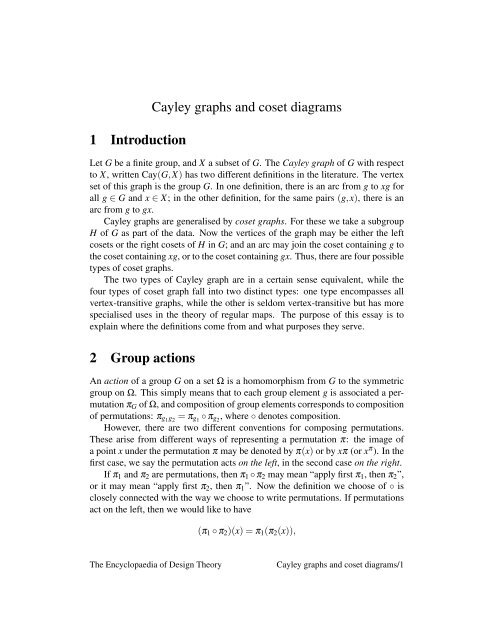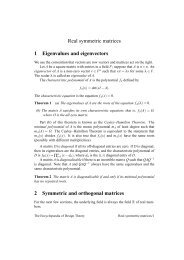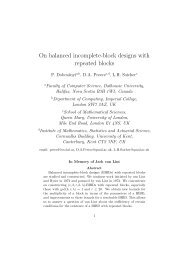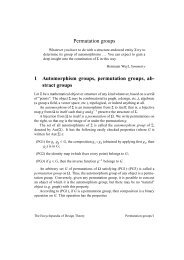Cayley graphs and coset diagrams 1 Introduction 2 Group actions
Cayley graphs and coset diagrams 1 Introduction 2 Group actions
Cayley graphs and coset diagrams 1 Introduction 2 Group actions
You also want an ePaper? Increase the reach of your titles
YUMPU automatically turns print PDFs into web optimized ePapers that Google loves.
1 <strong>Introduction</strong><strong>Cayley</strong> <strong>graphs</strong> <strong>and</strong> <strong>coset</strong> <strong>diagrams</strong>Let G be a finite group, <strong>and</strong> X a subset of G. The <strong>Cayley</strong> graph of G with respectto X, written Cay(G,X) has two different definitions in the literature. The vertexset of this graph is the group G. In one definition, there is an arc from g to xg forall g ∈ G <strong>and</strong> x ∈ X; in the other definition, for the same pairs (g,x), there is anarc from g to gx.<strong>Cayley</strong> <strong>graphs</strong> are generalised by <strong>coset</strong> <strong>graphs</strong>. For these we take a subgroupH of G as part of the data. Now the vertices of the graph may be either the left<strong>coset</strong>s or the right <strong>coset</strong>s of H in G; <strong>and</strong> an arc may join the <strong>coset</strong> containing g tothe <strong>coset</strong> containing xg, or to the <strong>coset</strong> containing gx. Thus, there are four possibletypes of <strong>coset</strong> <strong>graphs</strong>.The two types of <strong>Cayley</strong> graph are in a certain sense equivalent, while thefour types of <strong>coset</strong> graph fall into two distinct types: one type encompasses allvertex-transitive <strong>graphs</strong>, while the other is seldom vertex-transitive but has morespecialised uses in the theory of regular maps. The purpose of this essay is toexplain where the definitions come from <strong>and</strong> what purposes they serve.2 <strong>Group</strong> <strong>actions</strong>An action of a group G on a set Ω is a homomorphism from G to the symmetricgroup on Ω. This simply means that to each group element g is associated a permutationπ G of Ω, <strong>and</strong> composition of group elements corresponds to compositionof permutations: π g1 g 2= π g1 ◦ π g2 , where ◦ denotes composition.However, there are two different conventions for composing permutations.These arise from different ways of representing a permutation π: the image ofa point x under the permutation π may be denoted by π(x) or by xπ (or x π ). In thefirst case, we say the permutation acts on the left, in the second case on the right.If π 1 <strong>and</strong> π 2 are permutations, then π 1 ◦π 2 may mean “apply first π 1 , then π 2 ”,or it may mean “apply first π 2 , then π 1 ”. Now the definition we choose of ◦ isclosely connected with the way we choose to write permutations. If permutationsact on the left, then we would like to have(π 1 ◦ π 2 )(x) = π 1 (π 2 (x)),The Encyclopaedia of Design Theory<strong>Cayley</strong> <strong>graphs</strong> <strong>and</strong> <strong>coset</strong> <strong>diagrams</strong>/1
that is, “first π 2 , then π 1 ”; while if they act on the right, we would preferx(π 1 ◦ π 2 ) = (xπ 1 )π 2 or x π 1◦π 2= (x π 1) π 2.When there is a choice, I will use the right action, since the definition of compositionunder the right action is so much more natural. I will simplify the notationby writing simply xg for the image of x under the permutation π g . The rule for anaction becomes simply x(gh) = (xg)h.Now suppose that G acts (on the right) on a set Ω. The action is transitive ifwe can move from any point of Ω to any other by some permutation induced byG; that is, for any α,β ∈ Ω there is an element g ∈ G such that αg = β.Two <strong>actions</strong> of G, on sets Ω 1 <strong>and</strong> Ω 2 , are said to be isomorphic if there is abijection φ : Ω 1 → Ω 2 (which I shall also write on the right) such that (αφ)g =(αg)φ for all α ∈ Ω 1 <strong>and</strong> g ∈ G. In other words, up to renaming the points of theset, the <strong>actions</strong> are identical.Now let H be a subgroup of G. The right <strong>coset</strong>s of H are the sets Hx = {hx :h ∈ H}, <strong>and</strong> the left <strong>coset</strong>s are the sets xH = {xh : h ∈ H}, as x runs through G.Two <strong>coset</strong>s of the same type are either equal or disjoint; two elements x 1 ,x 2 lie inthe same right <strong>coset</strong> if <strong>and</strong> only if x 1 x2 −1 ∈ H, <strong>and</strong> lie in the same left <strong>coset</strong> if <strong>and</strong>only if x2 −1 x 1 ∈ H. So the <strong>coset</strong>s of each type form a partition of G. The subgroupH is normal in G if <strong>and</strong> only if the partitions into left <strong>and</strong> right <strong>coset</strong>s coincide.It is worth noting that there is a natural bijection between the right <strong>coset</strong>s <strong>and</strong> theleft <strong>coset</strong>s: to the right <strong>coset</strong> Hx corresponds the left <strong>coset</strong>x −1 H = {g −1 : g ∈ Hx}.The sets of left <strong>and</strong> right <strong>coset</strong>s of H are denoted by G/H <strong>and</strong> H\G respectively.(The position of G relative to H in the notation tells where the <strong>coset</strong> representativeshould be put.)Now there is an action ρ of G on the set of right <strong>coset</strong>s of H by the rule(Hx)ρ g = H(xg).This means that the permutation ρ g corresponding to g maps the <strong>coset</strong> Hx to the<strong>coset</strong> H(xg). (One must show that the image is independent of the choice of <strong>coset</strong>representative x, so that the map is well-defined; that the map is a permutation;<strong>and</strong> that the condition for an action holds. All of this is straightforward.) We canwrite this in our simpler notation as (Hx)g = H(xg) without too much confusion.Similarly, there is an action λ on the set of left <strong>coset</strong>s of H given by(xH)λ g = (g −1 x)H.The Encyclopaedia of Design Theory<strong>Cayley</strong> <strong>graphs</strong> <strong>and</strong> <strong>coset</strong> <strong>diagrams</strong>/2
(The inverse is required to make the action a homomorphism.) These two <strong>actions</strong>are isomorphic: the bijection in the preceding paragraph satisfies the conditionsfor an isomorphism of <strong>actions</strong>. We will concentrate on the action on right <strong>coset</strong>s.Clearly this is transitive.Conversely, every transitive action is isomorphic to an action on the right<strong>coset</strong>s of a subgroup. If G acts on Ω, <strong>and</strong> α ∈ Ω, the stabiliser of α is the subsetG α = {g ∈ G : αg = α}.It is a subgroup of G. If G acts transitively on Ω, then for each β ∈ Ω, the setX(α,β) = {g ∈ G : αg = β}is a right <strong>coset</strong> of G α , <strong>and</strong> the map β → X(α,β) is an isomorphism from the givenaction to the action on right <strong>coset</strong>s of G α .3 Graphs <strong>and</strong> permutationsWe will consider directed <strong>graphs</strong>, whose arcs are ordered pairs of vertices. Anundirected graph will be a directed graph with the property that if (v,w) is an arcthen so is (w,v); if this holds we speak of the edge {v,w}.A function f on a set Ω can be regarded as the set of all ordered pairs (α, f (α))for α ∈ Ω. We can regard these pairs as the arcs of a digraph, the functionaldigraph Φ( f ). A digraph is a functional digraph if <strong>and</strong> only if every vertex hasexactly one arc leaving it. The function f is a permutation if <strong>and</strong> only if everyvertex of Φ( f ) has exactly one arc entering it. If so, then Φ( f −1 ) is obtainedsimply by reversing all the arcs.Proposition 1 If f <strong>and</strong> π are permutations of Ω, then π is an automorphism ofthe functional digraph Φ( f ) if <strong>and</strong> only if π <strong>and</strong> f commute.Proof(απ, f (α)π) ∈ Φ( f ) ⇔ f (α)π = f (απ).Note the asymmetry: we have written f on the left <strong>and</strong> π on the right. Thismakes the commuting condition appear more natural!See [1] for more information on graph automorphisms.The Encyclopaedia of Design Theory<strong>Cayley</strong> <strong>graphs</strong> <strong>and</strong> <strong>coset</strong> <strong>diagrams</strong>/3
4 <strong>Cayley</strong> <strong>graphs</strong>An action of G on Ω is said to be regular if it is transitive <strong>and</strong> the stabiliser ofa point consists of the identity element of G only. Now the <strong>coset</strong>s (left or right)of the identity subgroup are the singleton subsets of G, which can be naturallyidentified with the elements of G. So any regular action of G is isomorphic to the“action of G on itself by right multiplication”, given by xπ g = xg for x,g ∈ G. Thesame result would be true if we used left multiplication.The <strong>Cayley</strong> graph of G with connection set X ⊆ G is defined to be the directedgraph whose arc set is the union of the arc sets of the functional di<strong>graphs</strong> Φ(λ x ),for x ∈ X. In other words, (g,xg) is an arc for all g ∈ G <strong>and</strong> x ∈ X. We denote thisgraph by Cay(G,X).Proposition 2 A digraph Γ with vertex set G admits G (acting by right multiplication)as a group of automorphisms if <strong>and</strong> only if Γ is a <strong>Cayley</strong> graph Cay(G,X)for some X ⊆ G.Proof In one direction we use the observation that the associative law for a groupG is a “commutative law” for the left <strong>and</strong> right multiplications:(xλ g )ρ h = (gx)ρ h = gxh = (xh)λ g = (xρ h )λ g .So if Γ is a <strong>Cayley</strong> graph, then right multiplication preserves the arc sets of all thefunctional di<strong>graphs</strong> Φ(λ x ) for x ∈ X, <strong>and</strong> hence the arc set of Γ.Conversely, suppose that Γ admits the right action of G. LetX = {x ∈ G : (1,x) is an arc of Γ}.Then applying g on the right we see that (g,xg) is an arc, for all x ∈ X <strong>and</strong> g ∈ G.Conversely, if (g,h) is an arc, then (1,hg −1 ) is an arc, so hg −1 ∈ X. Thus Γ =Cay(G,X).Proposition 3 The <strong>Cayley</strong> digraph Cay(G,X) is loopless if <strong>and</strong> only if 1 /∈ X; it isundirected if <strong>and</strong> only if X = X −1 ; <strong>and</strong> it is connected if <strong>and</strong> only if X generates G.The group G acts vertex-transitively on Cay(G,X).If “left” <strong>and</strong> “right” are reversed throughout this section (so that a <strong>Cayley</strong>graph is a union of functional di<strong>graphs</strong> for the right action, <strong>and</strong> automorphismsact on the left), then an equivalent theory is obtained. The literature is divided onthis point!The Encyclopaedia of Design Theory<strong>Cayley</strong> <strong>graphs</strong> <strong>and</strong> <strong>coset</strong> <strong>diagrams</strong>/4
5 Vertex-transitive <strong>graphs</strong>Now there are two ways of generalising <strong>Cayley</strong> <strong>graphs</strong>:• We may take the definition as a union of functional di<strong>graphs</strong> of permutations,<strong>and</strong> use arbitrary permutations;• We may regard vertex-transitivity as the important property <strong>and</strong> impose that.In this section I will consider the second approach.First a small digression. If H is a subgroup of G, then an H-H double <strong>coset</strong> isa subset of G of the formHxH = {h 1 xh 2 : h 1 ,h 2 ∈ H}.As with right <strong>and</strong> left <strong>coset</strong>s, it holds that G is a disjoint union of double <strong>coset</strong>s.However, the double <strong>coset</strong>s do not all have the same size: we have|HxH| =|H| 2|H ∩ x −1 Hx| .For it is easy to show that the denominator is the number of ways of writing anelement in the form h 1 xh 2 for h 1 ,h 2 ∈ H. The set of double <strong>coset</strong>s is writtenH\G/H. Double <strong>coset</strong>s of different subgroups H <strong>and</strong> K can also be defined butwe do not require this.Now suppose that Γ is a graph with vertex set Ω, <strong>and</strong> G a group of automorphismsof Γ acting vertex-transitively on Γ. As we saw earlier, the action of G onΩ is isomorphic to its action on the set of right <strong>coset</strong>s of a subgroup H of G (thestabiliser of a point α of Ω; so we can replace Ω by the set H\G of right <strong>coset</strong>s.How do we describe the arcs of Γ?Following the proof in the preceding section, letThen the following facts are easily seen:X = {x ∈ G : (α,αx) is an arc of Γ}.• Hg 1 is joined to Hg 2 if <strong>and</strong> only if g 2 = xg 1 for some x ∈ X;• X is a union of H-H double <strong>coset</strong>s;• Γ is loopless if <strong>and</strong> only if H ⊈ X;The Encyclopaedia of Design Theory<strong>Cayley</strong> <strong>graphs</strong> <strong>and</strong> <strong>coset</strong> <strong>diagrams</strong>/5
• Γ is undirected if <strong>and</strong> only if X = X −1 ;• Γ is connected if <strong>and</strong> only if X generates G;• G acts arc-transitively on Γ if <strong>and</strong> only if X consists of just one double <strong>coset</strong>.Conversely, if X is a union of H-H double <strong>coset</strong>s, <strong>and</strong> we define a digraph onH\G by the rule that Hg is joined to Hxg for all x ∈ X <strong>and</strong> g ∈ G, then the resultingdigraph, which we denote by Γ(G,H,X), is vertex-transitive. All vertex-transitivedi<strong>graphs</strong> (up to isomorphism) are thus produced by this construction:Proposition 4 Any vertex-transitive graph is isomorphic to a graph Γ(G,H,X),where G is a group, H a subgroup of G, <strong>and</strong> X a union of H-H double <strong>coset</strong>s.6 Homomorphisms <strong>and</strong> Sabidussi’s TheoremA homomorphism from a digraph Γ 1 to a digraph Γ 2 is a map f from the vertex setof Γ 1 to that of Γ 2 with the property that, if (v,w) is an arc of Γ 1 , then ( f (v), f (w))is an arc of Γ 2 . (There is no requirement about the case when (v,w) is not an arc.)Theorem 5 (Sabidussi [3]) Every vertex-transitive graph is a homomorphic imageof a <strong>Cayley</strong> graph.Proof We can represent our vertex-transitive digraph Γ as Γ(G,H,X). Now letΓ ′ = Cay(G,X), <strong>and</strong> define f (g) = Hg. Any arc (g,xg) of Γ ′ is mapped to an arc(Hg,Hxg) of Γ.For example, the Petersen graph is vertex-transitive but is not a <strong>Cayley</strong> graph,since its automorphism group has no transitive subgroup of order 10. However,the dodecahedron is a <strong>Cayley</strong> graph for the Frobenius group of order 20, <strong>and</strong>the map which identifies antipodal vertices induces a homomorphism from thedodecahedron to the Petersen graph.7 Coset <strong>diagrams</strong>Now we turn to the other possible generalisation of <strong>Cayley</strong> <strong>graphs</strong>. Given a set Xof permutations of Ω, define Φ(X) to be the digraph whose arc sets are the unionsof the arc sets of the functional di<strong>graphs</strong> Φ( f ), for f ∈ X. We can regard theThe Encyclopaedia of Design Theory<strong>Cayley</strong> <strong>graphs</strong> <strong>and</strong> <strong>coset</strong> <strong>diagrams</strong>/6
arcs of Φ(X) to be coloured by the elements of X, so that the arc (α, f (α)) hascolour f . We call this graph a <strong>coset</strong> diagram.There is not much to be said about this construction in general. It is useful inthe theory of regular maps.Suppose that M is a map embedded in a surface. A dart or flag of M is anordered triple consisting of a mutually incident vertex, edge <strong>and</strong> face of M. If Ωis the set of darts of the map, then one can define three permutations of Ω:• a : (v,e, f ) ↦→ (v ′ ,e, f ), where v ′ is the other end of the edge e;• b : (v,e, f ) ↦→ (v,e ′ , f ), where e ′ is the other edge incident with v <strong>and</strong> f ;• c : (v,e, f ) ↦→ (v,e, f ′ ), where f ′ is the face on the other side of the edge e.Clearly a,b,c are involutions (that is, a 2 = b 2 = c 2 = 1). Moreover, ab mapsa dart to the dart obtained by a rotation of the face f by one step; bc maps a dartto the dart obtained by a rotation of the edges at the vertex v by one step; <strong>and</strong> acmaps a dart to the dart obtained by reflecting in the midpoint of the edge e. Thus,we havea 2 = b 2 = c 2 = (ab) m = (bc) n = (ac) 2 = 1,where m <strong>and</strong> n are the least common multiples of the face sizes <strong>and</strong> vertex degreesof the map. The involutions a,b,c are fixed-point-free (acting on the set of darts),<strong>and</strong> the group they generate is transitive.Conversely, given three fixed-point-free involutions a,b,c satisfying these relations<strong>and</strong> generating a transitive group G, there is a map on some surface encodedby the three permutations. The automorphism group of the map consists ofpermutations of the darts commuting with the permutations defining the map.Now the permutations a,b,c are represented by <strong>coset</strong> <strong>diagrams</strong> for H in G,where H is the stabiliser of a dart. The advantage of a well-drawn <strong>coset</strong> diagramis that it makes it easy to check the relations satisfied by the three permutations.For example, if the diagram is symmetric about the vertical axis <strong>and</strong> ac is thereflection, then clearly (ac) 2 = 1.For a fine example of a <strong>coset</strong> diagram, see the portrait of Graham Higman, byNorman Blamey, in the Mathematical Institute, Oxford. Higman was a pioneer oftheir use in this context [2]. A recent survey [4] is also recommended.A <strong>coset</strong> diagram is not usually a vertex-transitive graph. In the special casewhere G acts regularly, a <strong>coset</strong> diagram for any set X of its elements is a <strong>Cayley</strong>graph Cay(G,X); <strong>and</strong> we have seen that it admits the vertex-transitive group G.A well-known result from permutation group theory asserts that if the centraliserThe Encyclopaedia of Design Theory<strong>Cayley</strong> <strong>graphs</strong> <strong>and</strong> <strong>coset</strong> <strong>diagrams</strong>/7
of a transitive group G is also transitive, then G is regular; so the only <strong>coset</strong> <strong>diagrams</strong>which admit vertex-transitive groups of colour-preserving automorphismsare <strong>Cayley</strong> <strong>graphs</strong>.Note that the rule for a <strong>coset</strong> diagram is that Hg is joined to Hgx for all g ∈ G,x ∈ X; compare the definition of the <strong>coset</strong> graph Γ(G,H,X), where Hg is joinedto Hxg.8 Normal <strong>Cayley</strong> <strong>graphs</strong>As we defined it, a <strong>Cayley</strong> graph for G is a graph on the vertex set G which admitsthe action of G on the right.Proposition 6 The following are equivalent for the <strong>Cayley</strong> graph Γ = Cay(G,X):(a) Γ admits the action of G on the left;(b) the connection set X is a normal subset of G, that is, g −1 Xg = X for allg ∈ G;(c) the connection set X is a union of conjugacy classes in G.Proof Clearly (b) <strong>and</strong> (c) are equivalent. If (a) holds, then left multiplicationtakes the arc (1,x) to (g,gx); so gxg −1 ∈ X for any g ∈ G, x ∈ X, whence X is anormal subset. The converse is shown in the same way.Obviously, every <strong>Cayley</strong> graph for an abelian group is normal; but this is falsefor any non-abelian group.The analogue of normal <strong>Cayley</strong> <strong>graphs</strong> for <strong>coset</strong> <strong>graphs</strong> has not been investigated.There is no “left action” of G on the set of right <strong>coset</strong>s of a non-normalsubgroup H. However, conditions (b) <strong>and</strong> (c) make sense even in this more generalcontext.9 Other developmentsIf Γ is a <strong>Cayley</strong> graph for a group G, then certainly G is contained in the automorphismgroup of Γ. A question which received a lot of attention was: When is Gthe full automorphism group. The graph Γ is said to be a graphical/digraphicalThe Encyclopaedia of Design Theory<strong>Cayley</strong> <strong>graphs</strong> <strong>and</strong> <strong>coset</strong> <strong>diagrams</strong>/8
egular representation of G (GRR or DRR) if the full group of automorphisms ofthe graph or digraph Γ is just G.Abelian groups with exponent greater than 2 never have GRRs. For if Γ =Cay(G,X) is undirected, then X = X −1 , <strong>and</strong> the map g ↦→ g −1 is an automorphismof Γ not lying in G. Similar remarks hold for generalised dicyclic groups, thoseof the form G = 〈A,t〉, where t 2 ∈ A, t 2 ≠ 1, <strong>and</strong> t −1 at = a −1 for all a ∈ A. Hetzel<strong>and</strong> Godsil showed that apart from these <strong>and</strong> finitely many others (all determinedexplicitly), every group has a GRR. It is now thought that, apart from these twoinfinite families of exceptions, a r<strong>and</strong>om undirected <strong>Cayley</strong> graph for the group Gis a GRR for G with high probability.Other research areas include catalogues of vertex-transitive <strong>and</strong> <strong>Cayley</strong> <strong>graphs</strong>,quasi-<strong>Cayley</strong> <strong>graphs</strong> (“<strong>Cayley</strong> <strong>graphs</strong> for quasigroups”), <strong>and</strong> the very importantarea of infinite <strong>Cayley</strong> <strong>graphs</strong> of finite valency. Various generalisations of vertextransitive<strong>graphs</strong>, such as <strong>graphs</strong> with constant neighbourhood, walk-regular <strong>graphs</strong>,<strong>and</strong> compact <strong>graphs</strong>, have also been studied. See [1] for some pointers to the literature.References[1] P. J. Cameron, Automorphisms of <strong>graphs</strong>, in Topics in Algebraic Graph Theory(ed. L. W. Beineke <strong>and</strong> R. J. Wilson), Cambridge Univ. Press, Cambridge,2004, pp.137–155.[2] G. Higman <strong>and</strong> Q. Mushtaq, Coset <strong>diagrams</strong> <strong>and</strong> relations for PSL(2,Z). ArabGulf J. Sci. Res. 1 (1983), 159–164.[3] G. Sabidussi, Vertex-transitive <strong>graphs</strong>, Monatsh. Math. 68 (1964), 426–438.[4] J. Širáň, Regular maps on a given surface: a survey, in Topics in DiscreteMathematics (ed. M. Klazar et al.), Algorithms <strong>and</strong> Combinatorics 26,Springer, Berlin, 2006, pp. 591–609.Peter J. CameronAugust 2, 2006The Encyclopaedia of Design Theory<strong>Cayley</strong> <strong>graphs</strong> <strong>and</strong> <strong>coset</strong> <strong>diagrams</strong>/9






